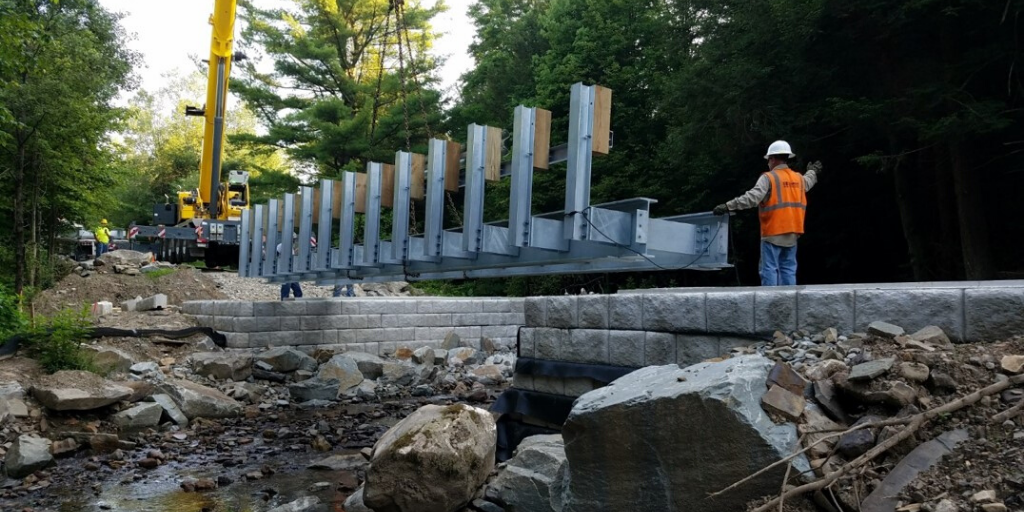Faced with upkeep of thousands of bridges on their local roads, municipal officials can turn to PennDOT for a cost-effective solution: the Geosynthetic Reinforced Soil-Integrated Bridge System (GRS-IBS). The system is also a viable alternative for low-volume, PennDOT-owned structures.
A method that can be traced back hundreds of years and was in use to build parts of the Great Wall of China, GRS-IBS is a Federal Highway Administration's (FHWA) Every Day Counts innovation championed by the Pennsylvania State Transportation Innovation Council (STIC).
"We are going back to looking at what worked in the past and bringing it to the forefront using modern materials," said Kristin Langer, one of PennDOT's assistant chief bridge engineers. "It reflects our constant search for cost-effective bridge replacement options. This method has the added bonus that it doesn't require specialized equipment or skilled craftspeople, keeps the workforce efficient and manage resources well."
GRS-IBS is a low-cost alternative for short-span structures that local work forces or district maintenance forces can construct using readily available materials and without expensive construction equipment. The bridge can be completed in weeks instead of months. Costs are 25 to 60 percent less than conventional methods.
PennDOT, through its municipal services offices in the districts and presentations at municipal conventions such as for the Pennsylvania State Association of Township Supervisors and the County Commissioners Association of Pennsylvania, has been working with municipalities and counties on advancing use of GRS-IBS.
"They were quick to embrace it," said Randy Albert, municipal services supervisor in District 2 based in Clearfield. "They saw the economy of the process and the ease of construction."
Albert was the first to bring GRS-IBS to PennDOT and is the agency's resident subject matter expert on the topic.
Thirty-three GRS-IBS bridges have been built or are in design across the state so far to PennDOT's knowledge. Since GRS-IBS has been fully implemented and used widespread, some municipalities have become proficient at building GRS-IBS on their own without PennDOT input.
Nationwide, according to FHWA, more than 200 bridges in 44 states, Puerto Rico and the District of Columbia have been selected for construction using GRS-IBS since the innovation was first championed in 2010.
According to FHWA, the technology consists of three main components: the reinforced soil foundation, the abutment, and the integrated approach. Alternating layers of compacted granular fill, blocks and geosynthetic reinforcement provide support for the bridge. The closely spaced reinforcement and granular soil create an efficient composite material that is internally stable and capable of carrying bridge loads significantly higher than designed with predictable and reliable performance.
The designer places the superstructure directly on the GRS-IBS substructure, creating a seamless and smooth transition between the bridge and approach roadway without joints, deep foundations, approach slabs, or waiting for cast-in-place concrete to cure. The smooth transition from the roadway to the bridge helps alleviate the "bump at the end of the bridge" problem caused by differential settlement between the bridge abutment and the approaching roadway.
Current constraints in Pennsylvania call for use of GRS-IBS only when the traffic volume on the bridge is 400 vehicles or fewer, the span is no more than 70 feet and the water velocities passing beneath the structure are no more than 12 feet per second.
"We are doing a research project with Penn State University to study what other DOTs and entities are doing with an eye to increasing the limits for span length, facing durability, and scour countermeasures," Langer and Albert said.
Support for the research came through STIC Incentive Program funding. Langer is project manager and Albert provides technical support and expertise.
"There were tight constraints originally set to make sure the system works well and is viable," she added. "Within Pennsylvania, we have a lot of scour and flooding concerns. The idea was to try it on small structures and in locations where there wouldn't be heavy impacts or safety concerns to the travelling public should it not perform the way we anticipated. Now that GRS-IBS has been in place for six years and the bridges seem to have weathered heavy water volumes and velocities during storms, we are looking to expand the design limitations by comparing our criteria to what other states are doing."
Lessons learned so far include ensuring the first layer of the foundation is level and true and making sure approach guiderail driving needs are addressed in between the wing walls and the roadway, Langer said.
The program reflects PennDOT's ongoing emphasis on reducing the backlog of pressing bridge maintenance needs across Pennsylvania, an issue that impacts mobility of many of the state's residents.
"We are a national leader," Albert noted.
